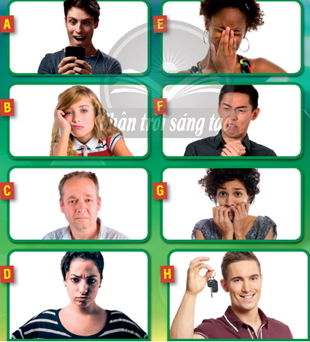Đừng bỏ lỡ những tính năng hấp dẫn của Baitap365.com
Unit 4: Feelings
Tiếng Anh 9 Unit 4 Vocabulary: Feelings and emotions
Tiếng Anh 9 Unit 4 Reading: An investigation Tiếng Anh 9 Unit 4 Language focus: Possibility and certainty Tiếng Anh 9 Unit 4 Vocabulary and listening: Music, mood and health Tiếng Anh 9 Unit 4 Language focus: Ability, advice and obligation Tiếng Anh 9 Unit 4 Speaking: Talking about feelings Tiếng Anh 9 Unit 4 Writing: A post on an advice forum Luyện tập từ vựng Unit 4 Tiếng Anh 9 Friends Plus Tiếng Anh 9 Friends Plus Unit 4 Từ vựngTiếng Anh 9 Unit 4 Vocabulary: Feelings and emotions
What kind of mood are you in today? Why? What things change your mood? 1.Read the Emotions test and match the adjectives in blue with nouns 1-12. 2.Remember 3.Choose the correct words to complete the questions. Then watch or listen. Which questions do the people discuss?
Think!
What kind of mood are you in today? Why? What things change your mood?
(Hôm nay bạn có tâm trạng như thế nào? Tại sao? Điều gì làm thay đổi tâm trạng của bạn?)
Bài 1
1. Read the Emotions test and match the adjectives in blue with nouns 1-12.
(Đọc bài kiểm tra Cảm xúc và nối các tính từ màu xanh lam với danh từ 1-12.)
The emotions test
This is a photo of a woman who is afraid. The emotion on her face is fear. When psychologists showed a picture like this to a group of adults and a group of teenagers, 100% of the adults correctly identified the emotion. However, only 50% of teenagers recognised that the emotion was fear. Some thought that it was surprise, others thought that it was anger. The results of many studies seem to show that in our teenage years we are not always good at recognising emotions.
Take the test. Match photos A-H with descriptions 1-8.
1. OK. It’s great that I won a prize for my project, but now everybody’s looking at me. Is that embarrassing or what?
2. I’ve got a friend who lets her pet dog lick her face sometimes. Yuck! I think it’s disgusting.
3. It’s stressful when my son is out late and doesn’t call. At least he could send me a message or something. He’s probably OK, but I’m still worried.
4. I hate it when I’m cycling and motorists drive too near me. Once I got really annoyed at a bad driver and I shouted at him at some traffic lights. I was SO angry.
5. When you find out that you’ve got a new baby cousin and you see how tiny he is, it’s very surprising. He’s so cute!
6. I’m not afraid of many things, but there’s something about wasps ... I just find them really frightening. I think I had a bad experience with them when I was young.
7. Watching this video about the history of Alaska is the most boring thing I’ve done in my life! And does anyone feel sympathetic for me? NO!
8. Yay!!! I’ve passed my driving test, at last! This is so exciting! And my instructor is going to be so pleased. These last two years of lessons haven’t exactly been relaxing for him!

Bài 2
Remember! (Ghi nhớ!)
Some adjectives have two possible endings: (Một số tính từ có thể có hai đuôi:)
-ed: describes one’s feelings (đuôi -ed: mô tả cảm xúc của một người)
I felt bored. (Tôi cảm thấy chán.)
-ing: describes the thing, person, or situation (đuôi -ing: mô tả sự vật, người hoặc tình huống)
The film was boring. (Bộ phim thì chán ngắt.)
My English teacher is amusing. (Giáo viên tiếng Anh của tôi rất thú vị.)
2. Do the Emotions test. Then check your answers with the key. How many did you get right?
(Làm bài kiểm tra Cảm xúc. Sau đó kiểm tra câu trả lời của bạn với đáp án. Bạn đã làm đúng được bao nhiêu?)
Bài 3
3. Choose the correct words to complete the questions. Then watch or listen. Which questions do the people discuss?
(Chọn những từ đúng để hoàn thành các câu hỏi. Sau đó xem hoặc nghe. Mọi người thảo luận những câu hỏi nào?)
1. When did you last feel embarrassed / embarrassing?
2. What kind of situations are stressed / stressful for you?
3. What activities do you find most relaxed / relaxing?
4. What are you frightened / frightening of?
5. What is your most annoyed / annoying habit?
Bài 4
4. Study the Key Phrases. Then watch or listen again. What answers are given to the questions in exercise 3?
(Nghiên cứu các Cụm từ chính. Sau đó xem hoặc nghe lại. Những câu trả lời nào được đưa ra cho các câu hỏi trong bài tập 3?)
KEY PHRASES (Cụm từ chính)
Talking about your feelings (Nói về cảm xúc của bạn)
I get quite / so ... when ... (Tôi cảm thấy khá / rất ... khi ...)
I’m not that bothered by ... (Tôi không bị làm phiền bởi ...)
There’s nothing ... about ... (Không có gì ... về ...)
It makes me feel really ... when ... (Nó làm cho tôi cảm thấy thực sự ... khi …)
What I find most ... is ... (Điều tôi thấy nhất ... là ...)
Bài 5
USE IT! (Sử dụng nó!)
5. Work in pairs. Ask and answer the questions in exercise 3. Use the key phrases.
(Làm việc theo cặp. Hỏi và trả lời các câu hỏi ở bài tập 3. Sử dụng các cụm từ khóa.)
Finished?
Think of alternative adjectives to describe the emotions in the photos.
(Hãy nghĩ ra những tính từ thay thế để mô tả cảm xúc trong các bức ảnh.)
Mẹo tìm đáp án nhanh
Search Google: "từ khóa + baitap365" Ví dụ: "Bài 5 trang 13 SGK Vật lí 12 baitap365